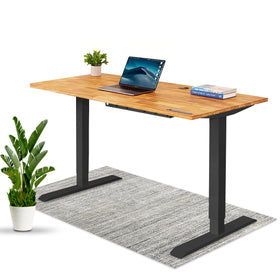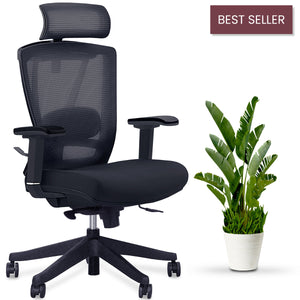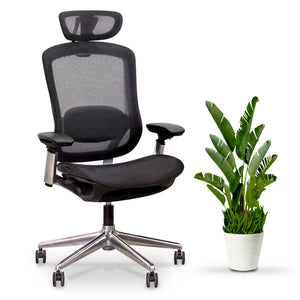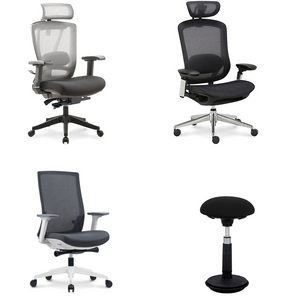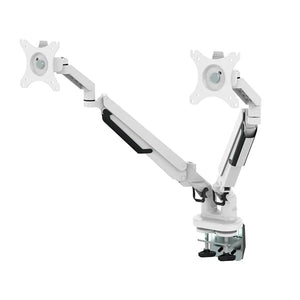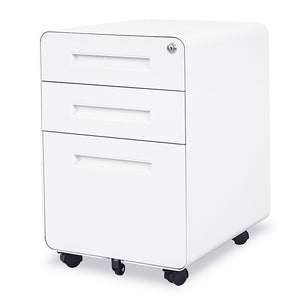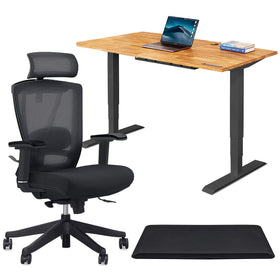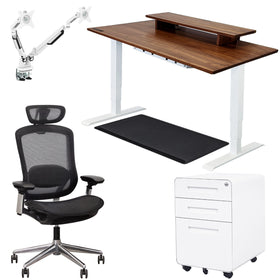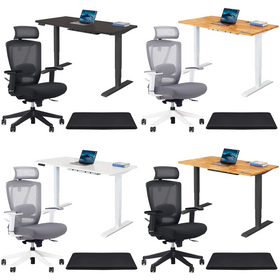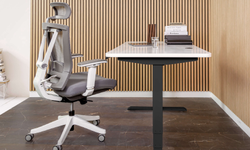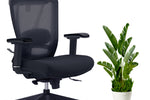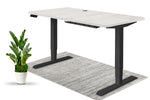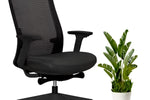-
Leather vs Mesh Office Chairs: The Pros and Cons April 11, 2024
-
7 Easy Soundproofing Hacks for Your Home Office April 2, 2024
-
How Prolonged Sitting Silently Damages Your Health March 21, 2024
-
How to Clean & Maintain Solid Wood Office Furniture March 7, 2024
-
AeryChair - Ergonomic Chair530 CAD
-
Standing Office DeskFrom835 CAD
-
GrinChair - Ergonomic Chair380 CAD
-
Home Office Standing DeskFrom715 CAD
Standing Desks vs Sitting Desks: 5 Key Differences
With modern professionals spending countless hours behind their desks, the way we interact with our workspaces has become a crucial aspect of our daily routines. The debate between standing desks and sitting desks is more relevant than ever, with health and productivity at the core of the conversation.
At EffyDesk, we offer a diverse selection of high-quality standing desks and ergonomic seating options to ensure the well-being of individuals, regardless of whether they prefer to stand, sit, or alternate positions throughout the workday. Let’s explore the five key differences between the standing desk vs sitting desk, delving into their impacts on health, productivity, ergonomics, cost, and adaptability.
1. Health Impacts
Standing Desks:
Standing desks not only encourage movement and help combat the sedentary lifestyle associated with sitting desks, but they also foster an active work environment conducive to physical health. By promoting a shift from prolonged sitting to standing, these desks have been linked to reduced risks of obesity, heart disease, and diabetes, highlighting their significant role in preventive health strategies.
The act of standing, as opposed to sitting, increases circulation throughout the body, which is vital for maintaining energy levels and preventing the stiffness and discomfort that come from sitting in one position for too long. Furthermore, the dynamic posture encouraged by standing desks helps improve overall posture and reduce the incidence of back pain. This is largely because standing engages various muscle groups across the body in a balanced way, ensuring that no single set of muscles is overburdened throughout the day.
Sitting Desks:
Prolonged sitting is closely associated with a higher risk of developing obesity, heart disease, diabetes, and experiencing a decline in metabolic health. Moreover, sitting for long durations can lead to poor posture and exacerbate back issues, as the body is not designed to be in a sedentary position for extended periods. This static posture can strain the neck, shoulders, and spine, leading to discomfort and long-term health problems. The cumulative effect of these health risks highlights the need for workplace strategies that encourage movement and posture variation.
Ergonomic solutions, such as adjustable chairs and desks, along with regular physical activity breaks, can mitigate some of the adverse effects of prolonged sitting, promoting a healthier and more dynamic working environment.
2. Productivity
Standing Desks:
Research indicates that the use of standing desks can significantly enhance productivity by fostering greater alertness and higher energy levels among employees. This increase in alertness is likely due to the improved circulation and oxygen flow that comes from standing, helping to keep the mind sharp and focused.
Additionally, the versatility of standing desks to allow users to effortlessly alternate between sitting and standing positions plays a crucial role in managing and mitigating fatigue. This flexibility ensures that workers can adjust their posture throughout the day according to their comfort and energy levels, thus preventing the slump in concentration that often occurs after prolonged sitting. The dynamic nature of switching postures can stimulate mental engagement and creativity, as changing physical perspectives can sometimes cause a shift in one’s viewpoint.
Sitting Desks:
While sitting desks are traditionally favored for their comfort, which can support prolonged periods of concentration, they inadvertently promote a sedentary lifestyle that carries with it several long-term drawbacks. The immediate comfort provided by sitting desks can facilitate deep focus and minimize distractions during tasks that require intensive attention. However, this very comfort can lead to extended periods of inactivity, which over time may result in decreased energy levels.
3. Ergonomics
Standing Desks:
Standing desks offer a more active and flexible approach to the work environment by promoting a dynamic working posture that can significantly enhance overall health and comfort. Unlike traditional sitting setups, these desks can be finely tuned to match the specific height and ergonomic requirements of each user, ensuring an optimal alignment of the monitor, keyboard, and other desk accessories. This customization plays a pivotal role in minimizing the risk of developing posture-related problems, such as neck strain, lower back pain, and shoulder tension, which are often exacerbated by static sitting positions.
The ability to adjust the desk height not only accommodates different body types but also encourages users to shift their standing position throughout the day, engaging different muscle groups and reducing the likelihood of muscle fatigue and stiffness. Furthermore, this ergonomic adaptability can lead to improved blood flow and increased physical engagement, even while performing desk-bound tasks.
Sitting Desks:
Ergonomic sitting desks and chairs are designed with the intention of minimizing health risks associated with prolonged periods of sitting by enhancing support for proper posture and diminishing strain on the body. These ergonomically designed workspaces are tailored to align with the body's natural posture, offering support to the back, neck, and wrists, and thereby reducing the risk of developing repetitive strain injuries or musculoskeletal disorders.
The strategic support provided can alleviate pressure on critical points of the body commonly affected by poor sitting habits, such as the lower back and shoulders, promoting a more comfortable and sustainable work environment. However, the effectiveness of these ergonomic solutions is not absolute and relies heavily on the user's commitment to incorporating regular movement into their routine. The static nature of sitting, even with ergonomic enhancements, can still contribute to health issues over time if not balanced with periodic standing and mobility exercises.
4. Cost
Standing Desks:
The innovative technology and corresponding benefits of standing desks typically cause them to be more expensive than their traditional sitting counterparts. These features enable users to seamlessly transition between sitting and standing positions, catering to a dynamic work style that can significantly enhance physical well-being and work performance. The added expense of these adjustable desks is often reflective of the engineering and design efforts required to create a durable, flexible, and user-friendly workspace solution.
Sitting Desks:
Sitting desks are widely recognized for their affordability and the diverse range of designs and materials available, making them an accessible option for many individuals and organizations. This variety allows for a high degree of customization in workspace design, enabling users to select desks that fit their aesthetic preferences and budgetary requirements. The lower cost of sitting desks compared to their standing counterparts can make them an appealing choice for outfitting offices or home study areas, especially when purchasing in bulk or on a tight budget.
5. Adaptability
Standing Desks:
Standing desks stand out for their adaptability to a wide range of tasks and individual preferences, fundamentally changing the way workspace ergonomics are approached. The key feature of many standing desks is their adjustable height, which can be tailored to meet the ergonomic requirements of virtually any user, regardless of their height or the specific demands of their work. This versatility is particularly beneficial in shared or multi-use environments where different individuals may use the same workstation at different times.
Sitting Desks
Traditional sitting desks, while offering stability and a familiar work setting, inherently provide limited options for posture variation throughout the day. This limitation is a key consideration in the context of ergonomic health, as remaining in a single posture for extended periods can contribute to discomfort and long-term musculoskeletal issues.
Ultimately, when choosing between a standing desk vs a sitting desk, it comes down to your personal objectives. Among the many benefits of a standing desk, users can alternate between sitting and standing, providing all the advantages of a traditional sitting desk. For more guidance on selecting the right equipment for your workspace, do not hesitate to contact our team of experts at EffyDesk.







